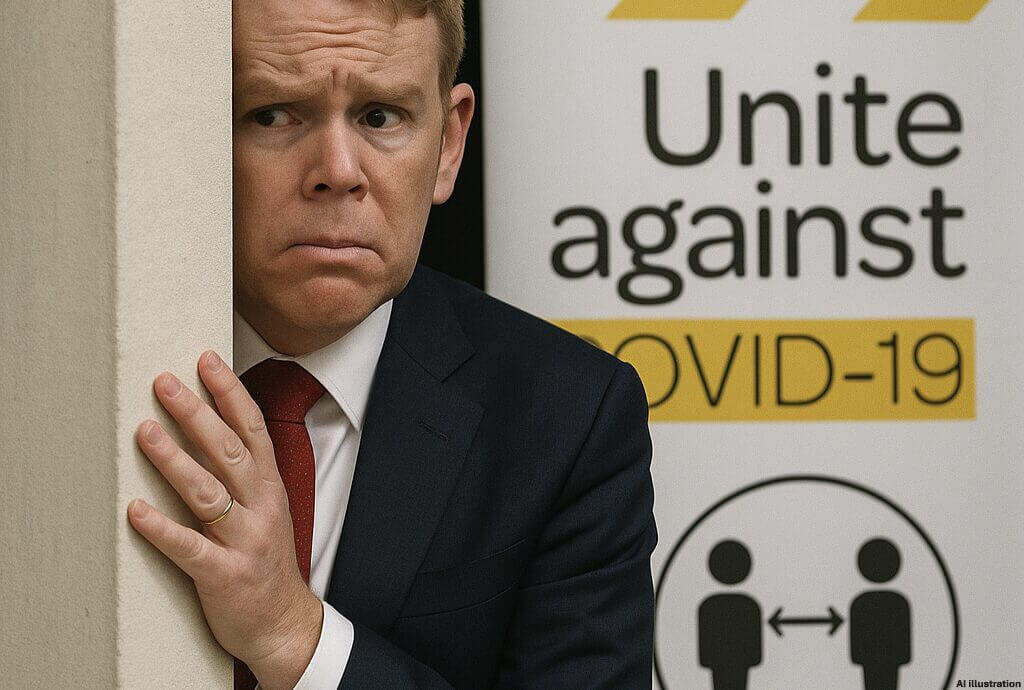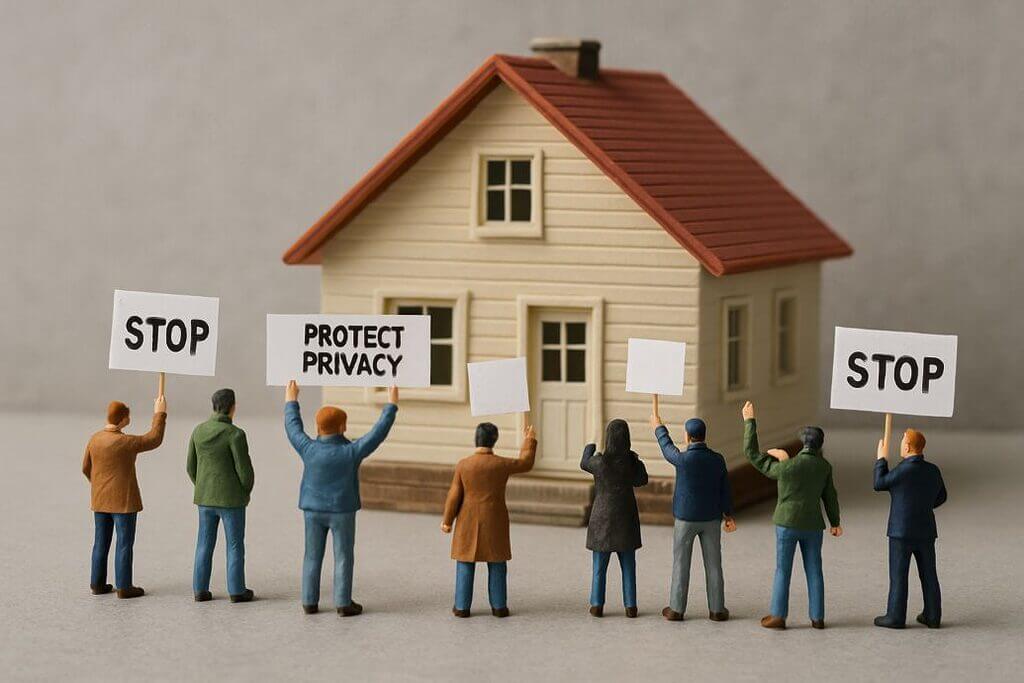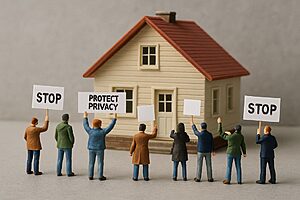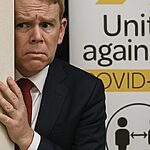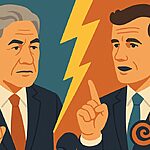By Centrist
A shipwreck north of Auckland leaking oil since 1940 is described by Hauraki Gulf environmental experts as ‘a clear and present danger’ – but despite repeated requests to Environment and Transport Ministers, the Ministries won’t release money to survey the wreck.
The Centrist asks why successive Ministers wouldn’t greenlight an examination of the wreck, to see if a clean up is required – and how time sensitive it is .
Keith Gordon’s phone rings hot in the week that the Centrist gets hold of him to chat about the ‘ticking timebomb’ leaking oil in marine reserves north of Auckland. The issue may be urgent now – however, it dates back to the 1940s. What’s changed in 2024? An all-time-high total of oil has leaked to the surface from the RMS Niagara this year, plus the ever increasing rust continually makes the ship more primed to break apart. Also, there is a new government so there is fresh hope of convincing them to be more concerned about the potential for the largest oil spill in NZ’s history.
Gordon, a diver and explorer, is one of the owners of salvage rights on the RMS Niagara shipwreck, which lies near the Mokohinau Islands at the north end of the Hauraki Gulf.
Gordon’s interest in the wreck was initially about the $1m worth of gold bars still there. We are taking him at face value that his concern is now about the environment and not about convincing the Crown to do something that has the side benefit of making these bars more recoverable.
Gordon told the Centrist in early May 2024 he continues to battle to get the Ministry for the Environment to release funding to clean up the wreck before NZ’s worst-ever oil spill occurs.
Why the rush, considering there hasn’t been a major release of oil in the 80 years the vessel has lain on the seafloor?
- Once the Niagara went down in 1940, it released enough oil from its forward tanks to stain the beaches of Mangawhai. So, it is very likely another significant leak from the other tanks will pollute the beaches of Northland and Auckland.
- Much more heavy fuel oil may remain in the ship’s lowest-level tanks and holds. These tanks are like coffer dams, Gordon told the Centrist – meaning they can’t all be drained in one go.
- The quantity of oil remaining is estimated to be 1000-1400 tonnes – far exceeding any previous NZ oil spill amount.
- Gordon has sighted rusticles and rust damage in the wreck on previous dives indicating that the hulls and tanks are falling apart.
- Oil slicks up to 15km in length have been spotted in Bream Bay; frequent black bubbles of oil rise to the surface every day.
Most stakeholders – including local government, marine salvage experts, Mangawhai residents, iwi and even thousands of school children who petitioned the Labour government deem the matter serious and very urgent – raising the question of why the government hasn’t cleaned it up sooner.
The sinking of the Niagara, the cover-up and the ticking timebomb
The oil leak saga began on June 19 1940. The trans-Pacific passenger ship RMS Niagara was headed north out of Auckland towards Suva, for passage to Vancouver, Canada, when a thunderous explosion shook the bow.
As the 349 passengers scrambled for 18 lifeboats, the ship struck another of the 228 mines the Germans had lain. Sinking came rapidly.
Every one of the passengers fortunately escaped. The wreck sank in 120 metres of water, and the 590 gold ingots (each valued at £4,300, totalling £2,537,000 ) were mostly recovered in salvage dives in the 1940s and 1950s. However, the bottom of the ship was lined with heavy fuel oil – which began leaking immediately after the bombing.
NZ’s stringent wartime censorship laws enabled NZ’s government to cover up the first oil leak, which was serious enough to stain the beaches of Mangawhai (60km away) in oil slicks up to 10cm deep.
The ship had capacity to carry 5000 tons of heavy fuel oil, and much of this gushed to the surface immediately after the mine explosion, with the Northern Advocate reporting at the time that the water’s surface was “covered with oil gushing from the Niagara’s fuel tanks.”
Detail indicating a major oil spill had occurred couldn’t be suppressed, with newspapers at the time mentioning that local Māori were unimpressed oil was destroying their fishing harvests, Mangawhai locals forced to clean beaches, and dead birds washing up for miles around.
Why won’t the government heed experts’ calls to pay to survey the wreck?
With his passion for protecting the Hauraki Gulf’s marine reserves, former Auckland Regional Councillor and marine expert Mike Lee has become a natural ally of Keith Gordon over the years.
Lee calls the wreck ‘a clear and present danger’ which “could be catastrophic in its consequences.”
Lee and Gordon have been some of the leaders in confronting Maritime NZ with requests to take stronger action against the leak.
By around 2018, Maritime NZ was taking Lee’s and Gordon’s concerns seriously enough that in 2019 and 2020 it asked the Ministry for the Environment for millions to survey the wreck with a mind to cleaning it up on subsequent dives.
Astonishingly, the requests of Maritime NZ were rebuffed – and the Ministry’s reasons partly redacted.
- Maritime NZ requested $4.1m-$6.6m in relation to the Niagara wreck from Associate Minister of Transport Julie Anne Genter and Phil Twyford (2017-2020)
Maritime NZ also asked for a mere $1m of help from Environment Ministry under Eugenie Sage in 2019–2020 financial year, at a time when the Ministry had a $1bn budget
- In September 2018, a Maritime NZ report to associate transport minister Julie Anne Genter and conservation minister Eugenie Sage recommended a comprehensive underwater survey and environmental risk analysis be carried out.
- all of these requests were turned down by senior ministers.
The so-called ‘Genter Report’ estimated that the cost of a cleanup would be $108m – twice as much as the $47m cost to taxpayers of cleaning up the Rena’s oil spill (the cost to the owners, and the cost to shift the wreckage, totalled many times that amount).
Lee told the Centrist it is “interesting” that experienced members of the Green Party were the ones who have failed to take action against the oil leak. In the past, Genter has campaigned with slogans including “Keep fossil fuels in the ground.”
However, subsequent Labour ministers didn’t take action either, with a June 2023 article by reporter Mike White saying [at the time] associate transport minister Kiritapu Allan “Is showing less interest in dealing with the Niagara than her predecessors.”
“While previous ministers wanted answers to the most basic questions – how much oil is on board, and what is the risk of it spilling – Allan doesn’t even support a preliminary survey of the wreck to find these answers, and hasn’t made a new budget bid,” White reported.
Allan’s statement was “Given the uncertainty over what oil may remain on the wreck, and the significant risk of disturbing the wreck and causing a spill in trying to determine this, the Government has no current plans to attempt any oil removal from the wreck.”
Countries worldwide are aware of the toxicity of WWII shipwrecks – so why is NZ burying its head in the sand?
A research paper published in the Marine Pollution Bulletin in 2015 pointed out that there are over 8500 sunken shipwrecks around the world posing a significant risk for oil pollution.
Even in the South Pacific alone, there are over 3800 vessels lost in the Pacific and East Asia. The report notes growing worldwide concern about the risk of oil leaks outstripping saltwater’s natural ability to dissolve and break up oil.
The Government has changed, but will that translate into a willingness to clean up the Niagara?
After Lee and Gordon first began loudly asking Government to budget money to assess the ship’s tanks and work out how much oil might be in the wreck, Lee says the first response from Maritime NZ was “The official line, ‘nothing to see here.’”
“They told us the oil is so deep it would have solidified from the cold, so not a problem,” Lee told the Centrist. “But when we pointed out to them the oil was leaking out it completely undermined that argument. The wreck [lies where the water is] temperature of a fridge – it’s not enough to turn oil solid.”
Lee says it is to their credit that Maritime NZ began asking for money to survey the oil risk in 2019.
In February 2024, Maritime NZ planned to reach into its existing budget to send a team to survey the oil leak – but this was called off due “operational and technical challenges”.
Maritime NZ hasn’t yet told the Centrist if it has lined up another date to investigate the leak.
Meanwhile, the wreck lies at risk of an earthquake releasing the oil and contaminating the Poor Knights, Tawharanui and Goat Island marine reserves.
“The wreck could not be in a more sensitive location,” Lee says.
Today, Maritime NZ’s position is that small amounts of oil continually leaking will naturally dissipate and evaporate as it does in nature.
While he’s grateful that Maritime NZ wants to take action, he wants to see if it results in actual action. Gordon told the Centrist he is frustrated that successive Ministers of Transport and the Environment have done nothing.
“We’re going round in circles… navel-gazing for the past 40 years. It’s out of sight out of mind, same old story – but if you go out on a boat you get oil on your equipment and you can smell it.
“Maritime NZ aren’t trying to hide from it. It’s just that successive governments won’t come up with the money. …they are spinning the roulette wheel. Advice from overseas is telling the Ministry for Environment it won’t cause much damage as it slowly leaks, but our ROV divers [tell another story].”
“The less the government know, the better they think it is. If they go survey now and it does show what we’re thinking, they would then not be able to just walk away.”
Gordon says if the oil does breach, Northland’s environmental and district councils would struggle to offer the facilities to clean it up. “They would have to get the equipment from Australia, and while they do that, there’ll be a lot of oil floating around doing damage.”
Northland Regional Council’s Marine Oil Spill Contingency Plan says that once a vessel has sunk, the procedure is to ‘Determine amount of oil on board and whether tanks were isolated, as well as fuel vent locations for Dive team.’ This has not been done with the RMS Niagara, and the Northland Regional Council has never addressed the Niagara’s regular surface oil spills despite 80 years of leaks.
“It’s not if it’s going to leak,” Gordon says, “It’s when.”..Of course this presupposes there is a lot of oil left, which is the million dollar question.
For today’s Coalition government, it’s an inherited problem from a game of political ‘pass the parcel’. The upside is maybe nothing happens on their watch.
Feature image: RMS “Niagara”. Reginald Arthur Borstel, Aust.

